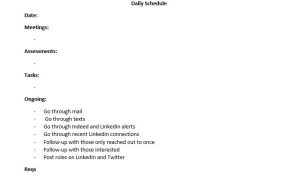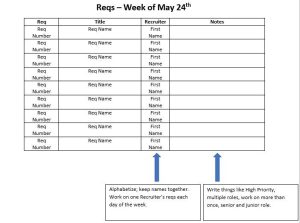Whether you just started your first role as a Sourcer or Recruiter or you have been doing it since the days of the rolodex, you could probably use some help with organization and prioritization we often feel like Stretch Armstrong, as we are pulled in a million different directions every day. “This role is high priority; I need people now.” “I need that JD put together today, so the role can go live.” “Do you have those analytics yet?” In our job, the HMs, the Managers, our colleagues, etc. do not seem to understand we have a lot more going on than just the tasks we are working on for them. It would be great to be dedicated to one HM, to one Talent Partner, or one Recruiter, but that is often not the case.
I am a disorganized person. In fourth grade my parents hired a math tutor for me, even though I was not bad at math; it was one of my strong suits. Years later, I found out the tutor was not there to teach me about math, but instead to teach me how to be organized. Tricky! I have ADD, so it can be hard for me to prioritize or stay on task, but I also have OCD which I try to have won out.
Since I started in Sourcing over seven years ago, I have learned a lot about the organization, because it was necessary! I have worked for companies without a CRM, where I ran my own custom one with tens of thousands of people out of multiple Google Sheets. I have become well versed in analytics and statistics. I took a four-hour Excel class once and was more excited about it than I like to admit. I love data. I love pulling reports. I love numbers. If I were more organized, I might have gone into a different career path earlier on in life.
But here I am, a Talent Sourcer who has worked in RPO, corporate, and agency. I have worked high-volume roles, I have worked niche roles, and most recently – I have worked high-volume, niche roles. I did not even know those were a thing! While I do not always have my ish together, I think I have managed to become pretty organized in how I deal with all of the tasks, deadlines, and to-dos I have every day. And that is what I am going to show you.
There are three things I use every day and I am not talking about open web, the Hiretual extension, or the ATS. I have three documents I use to stay on top of things. One of them is a Daily Schedule which includes Meetings, Phone Calls with Candidates, one-off tasks, daily tasks, and my req load. Secondly, I have a Google Sheet that helps me track and prioritize my req load, my candidates in process and my searches. Last but not least, I have recently put together a little table of my weekly reqs to help me audit what I have worked on, what I need to work on, and what I should spend more time on before the wonderful, but short, weekend arrives.
And here they are.
Daily Schedule
I put together a Daily Schedule every morning or at the conclusion of my work day in order keep track of things like Meetings, Phone Screens, Tasks for that day, ongoing tasks, and my req load.
Feel free to create this in a Word doc and fill in the blanks. I kept my Ongoing in the schedule, as I feel it will be similar for others.
Print it out! Cross things off. Crumple it up at the end of the day and shoot it into the trash can across the room. It is a fact that crossing things out helps us feel more accomplished, so go ahead and feel that at the end of the day! It might feel like we will never get everything done and we get stuck on what we did not do vs. ALL that we did accomplish. Do not feel that way. Now, if only I could tell myself that.

Weekly Reqs
Just last week, I decided to create another printout for the Reqs part. I print this out and hang it up because it helps me stay organized. I am able to prioritize and note which req I worked and how many times I worked on it throughout the week.

The Google Sheet
Over the past seven years, I have become a Google Sheet expert. I live my life out of these documents. I keep track of everything in Google Sheets, whether I am looking for a new job, a place to live, or budgeting. So, you could say that I know what I’m doing with these things.
I use Google Sheets at work for three main things: tracking reqs, tracking candidates, and tracking search strings I have done for each req. The Reqs tab lists things like the Recruiter and HM for the role, if I completed all necessary tasks before I started sourcing, the salary for the role, if the role offers Sponsorship, Relocation, etc. I also write down what I did each week for each req.
I utilize the Candidates tab to track the most recent step the candidate was in, when they were put in that step, and when I last checked the status. This is a great way to make sure your candidates keep moving through the process.
The Search tab helps you track where you used a search string, the date it was used, and if you set up an alert.
The Color columns can be whatever you want. I like to say that Green means high priority when it comes to reqs or in process when it comes to candidates. Red means hold off for now when it comes to reqs or did not advance when it comes to candidates. You do with it whatever works for you!
Feel free to download the Google Sheet here and fill in the blanks!
In Conclusion
We are incredibly busy. There is never a day where we sit around looking for work. All reqs always seem like high priorities. If you are one of those weirdos that can remember all of this off the top of your head – I am sorry you read all this article. If you could use a little extra help to keep on track and be as successful as possible, try these things out.
I also would love to hear about what you use to stay on track! And if you have any additional questions, you know where to find me!
